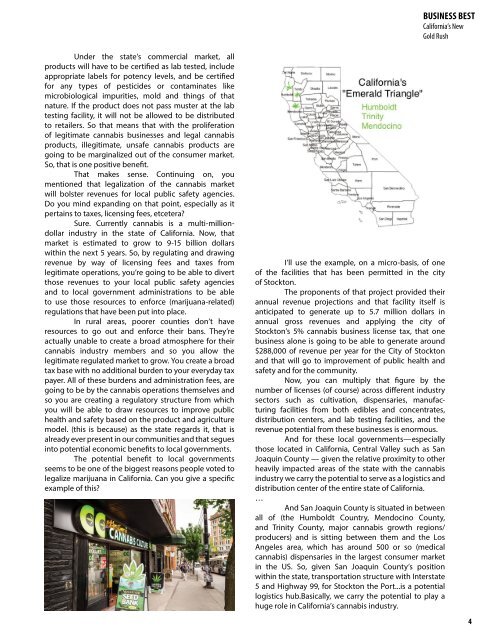Create successful ePaper yourself
Turn your PDF publications into a flip-book with our unique Google optimized e-Paper software.
BUSINESS BEST<br />
California’s New<br />
Gold Rush<br />
Under the state’s commercial market, all<br />
products will have to be certified as lab tested, include<br />
appropriate labels for potency levels, and be certified<br />
for any types of pesticides or contaminates like<br />
microbiological impurities, mold and things of that<br />
nature. If the product does not pass muster at the lab<br />
testing facility, it will not be allowed to be distributed<br />
to retailers. So that means that with the proliferation<br />
of legitimate cannabis businesses and legal cannabis<br />
products, illegitimate, unsafe cannabis products are<br />
going to be marginalized out of the consumer market.<br />
So, that is one positive benefit.<br />
That makes sense. Continuing on, you<br />
mentioned that legalization of the cannabis market<br />
will bolster revenues for local public safety agencies.<br />
Do you mind expanding on that point, especially as it<br />
pertains to taxes, licensing fees, etcetera?<br />
Sure. Currently cannabis is a multi-milliondollar<br />
industry in the state of California. Now, that<br />
market is estimated to grow to 9-15 billion dollars<br />
within the next 5 years. So, by regulating and drawing<br />
revenue by way of licensing fees and taxes from<br />
legitimate operations, you’re going to be able to divert<br />
those revenues to your local public safety agencies<br />
and to local government administrations to be able<br />
to use those resources to enforce (marijuana-related)<br />
regulations that have been put into place.<br />
In rural areas, poorer counties don’t have<br />
resources to go out and enforce their bans. They’re<br />
actually unable to create a broad atmosphere for their<br />
cannabis industry members and so you allow the<br />
legitimate regulated market to grow. You create a broad<br />
tax base with no additional burden to your everyday tax<br />
payer. All of these burdens and administration fees, are<br />
going to be by the cannabis operations themselves and<br />
so you are creating a regulatory structure from which<br />
you will be able to draw resources to improve public<br />
health and safety based on the product and agriculture<br />
model. (this is because) as the state regards it, that is<br />
already ever present in our communities and that segues<br />
into potential economic benefits to local governments.<br />
The potential benefit to local governments<br />
seems to be one of the biggest reasons people voted to<br />
legalize marijuana in California. Can you give a specific<br />
example of this?<br />
I’ll use the example, on a micro-basis, of one<br />
of the facilities that has been permitted in the city<br />
of Stockton.<br />
The proponents of that project provided their<br />
annual revenue projections and that facility itself is<br />
anticipated to generate up to 5.7 million dollars in<br />
annual gross revenues and applying the city of<br />
Stockton’s 5% cannabis business license tax, that one<br />
business alone is going to be able to generate around<br />
$288,000 of revenue per year for the City of Stockton<br />
and that will go to improvement of public health and<br />
safety and for the community.<br />
Now, you can multiply that figure by the<br />
number of licenses (of course) across different industry<br />
sectors such as cultivation, dispensaries, manufacturing<br />
facilities from both edibles and concentrates,<br />
distribution centers, and lab testing facilities, and the<br />
revenue potential from these businesses is enormous.<br />
And for these local governments—especially<br />
those located in California, Central Valley such as San<br />
Joaquin County — given the relative proximity to other<br />
heavily impacted areas of the state with the cannabis<br />
industry we carry the potential to serve as a logistics and<br />
distribution center of the entire state of California.<br />
…<br />
And San Joaquin County is situated in between<br />
all of (the Humboldt Country, Mendocino County,<br />
and Trinity County, major cannabis growth regions/<br />
producers) and is sitting between them and the Los<br />
Angeles area, which has around 500 or so (medical<br />
cannabis) dispensaries in the largest consumer market<br />
in the US. So, given San Joaquin County’s position<br />
within the state, transportation structure with Interstate<br />
5 and Highway 99, for Stockton the Port...is a potential<br />
logistics hub.Basically, we carry the potential to play a<br />
huge role in California’s cannabis industry.<br />
4





